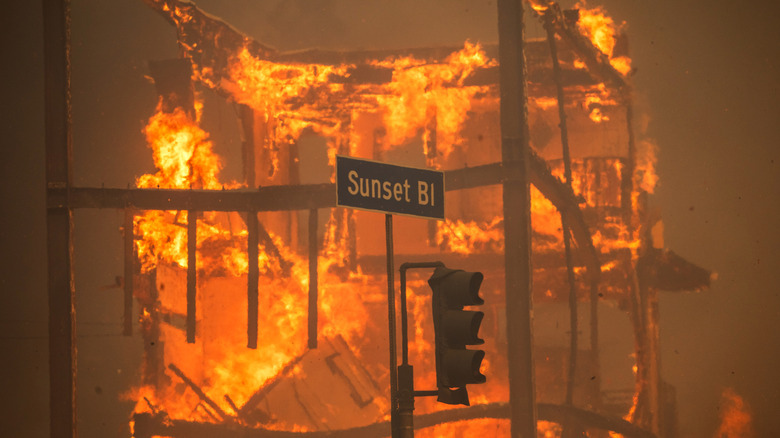You'll Feel The Financial Burn Of LA Fires - Even If You're Nowhere Near
The new year began with a torrent of images featuring burnt homes and evacuating residents. By now you are more than likely aware of the wildfires that have ripped through thousands of acres in Los Angeles. The situation even warranted a Major Disaster Declaration from President Biden, which allows the state to access federal aid (since fighting wildfires costs more than you think). As of January 24, 2025 multiple wildfires are still actively burning in Southern California with many of Los Angeles' largest fires still only partially contained. The combined January wildfires have killed 27 people (31 are still missing), burned through more than 40,000 acres, and have destroyed more than 15,000 structures in the region. And all of that is only so far, with many experts expecting the total figures across these categories to rise by the time the fires are entirely put out.
While the total cost for these wildfires is still accumulating, Wells Fargo and Goldman Sachs released an initial estimated cost of $30 billion for insurers, with non-insured damages rising as high as $40 billion. However, weather data company AccuWeather estimated total damage and economic loss at between $250 and $275 billion. All of this to say, these wildfires are guaranteed to be among the most expensive disasters in U.S. history. While the dust has, quite literally, not settled yet, insurance companies are already gearing up to raise prices on homeowners insurance premiums across the country (premiums which have already been spiking and even affecting the housing market).
How you'll end up paying more
There is no federal regulation on insurance rates. Instead, a patchwork of different regulations affect each state differently. As a result, many insurance companies will significantly raise rates in the states that allow it in order to offset the costs of disasters in other states with more strict regulation. Carmen Balber, executive director of Consumer Watchdog, told CNN, "In states where regulators apply less scrutiny, insurers are able to charge whatever they want. If regulations were stronger across the country, we'd all have lower rates."
According to Ishita Sen, a professor at Harvard Business School and one of the authors of a 2022 study on the effects of climate disasters on homeowners insurance prices, "The past suggests that after big wildfires, other states have ended up paying for it," he told CNN. However, it's important to realize that this is not just a wildfire-specific phenomenon or an issue stemming just from California. Hurricanes, tornados, hail, and other natural disasters also lead to similar outcomes for consumers across the country. In fact, Texas is the state that has actually had the most billion-dollar disasters since 1980 (190 of them according to National Centers for Environmental Information). Plus, these kinds of natural disasters are only expected to increase in both frequency and severity. According to the Insurance Information Institute, all but one of the top 10 most expensive hurricanes in U.S. history have happened since 2005. According to USAFacts, since 1980 there have been a whopping 395 different billion-dollar natural disasters.
Insurance companies
While it can be easy to vilify a specific state for its natural disasters, it's important to keep the focus for higher premiums squarely on the insurance industry. While the uptick in natural disasters does, in fact, lead to generally higher costs for insurance companies, the rate with which they have increased their premiums far outpaces any specific disaster.
In January 2024, Travelers Insurance closed at an all-time high after reporting record profits for its 2023 Q4. The company increased its rates by more than 15% between 2023 and early 2024. Progressive Insurance similarly reported a bump in profits at the end of 2023, with Q4 profits more than doubling from the year prior. The company's market capitalization soared past $100 billion for the first time ever in early 2024. Progressive has aggressively increased its rates everywhere, from almost 14% rate increases in California to almost 20% increases in West Virginia. Allstate's chief executive, Tom Wilson, stated in a February 2024 earnings call that, "Since 2022, the Allstate brand implemented rate increases of 33.3%, which included 16.4% in 2023 and 6.9% in the fourth quarter, driven by the recent approvals in California, New York, and New Jersey." Allstate boasted $1.2 billion in profits in the third quarter of 2024.
As Douglas Heller, director of insurance at the Consumer Federation of America, explained to the Wall Street Journal, "Insurers kicked their rate hikes into high gear in 2023, which has been thrilling to investors. But for everyone who has to buy coverage, it has been very difficult."


